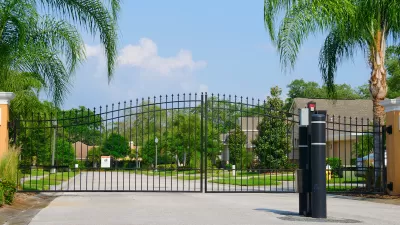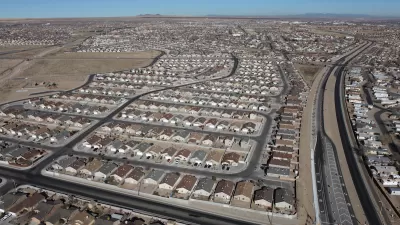Explicitly racist and exclusionary language remains embedded in many communities' restrictive covenants. State legislators and local leaders want to change that.

Although race-based restrictive covenants were rendered unenforceable by the 1968 Fair Housing Act, communities across the country linger in the shadow of their legacy as the language restricting residency remains in many property deeds. Wufei Yu reports on racial covenants in Albuquerque, where mid-century deed restrictions kept Black and Latino residents from buying homes in many parts of the city.
While "some Albuquerque title companies omitted restrictions based on race, color or national origin, scrubbing the racist language from their covenants," many kept the language in its original form. "In March, High Country News reviewed 10 property deeds in historically white neighborhoods closings and found that four of them still included racially offensive language from the city’s segregated past." Despite New Mexico's multiethnic origins—by 1920, the state was "home to nearly 6,000 African Americans, about 500 Asian Americans and over 19,000 Indigenous people"—a backlash against minorities led to the adoption of the "Alien Land Law" in 1921, which "barred people of Asian descent from owning and leasing real estate." The Alien Land Law wasn't removed from the state's constitution until 2006.
Today, "state Senators Daniel Ivey-Soto and Jerry Ortiz y Pino are drafting a bill that would encourage the removal of all racial covenants," calling the language a dangerous precedent for "viciously racist" policies like the 1882 Chinese Exclusion Act.
FULL STORY: Albuquerque’s racist history haunts its housing market

Planetizen Federal Action Tracker
A weekly monitor of how Trump’s orders and actions are impacting planners and planning in America.

The Simple Legislative Tool Transforming Vacant Downtowns
In California, Michigan and Georgia, an easy win is bringing dollars — and delight — back to city centers.

San Francisco's School District Spent $105M To Build Affordable Housing for Teachers — And That's Just the Beginning
SFUSD joins a growing list of school districts using their land holdings to address housing affordability challenges faced by their own employees.

In More Metros Than You’d Think, Suburbs are Now More Expensive Than the City
If you're moving to the burbs to save on square footage, data shows you should think again.

The States Losing Rural Delivery Rooms at an Alarming Pace
In some states, as few as 9% of rural hospitals still deliver babies. As a result, rising pre-term births, no adequate pre-term care and "harrowing" close calls are a growing reality.

The Small South Asian Republic Going all in on EVs
Thanks to one simple policy change less than five years ago, 65% of new cars in this Himalayan country are now electric.
Urban Design for Planners 1: Software Tools
This six-course series explores essential urban design concepts using open source software and equips planners with the tools they need to participate fully in the urban design process.
Planning for Universal Design
Learn the tools for implementing Universal Design in planning regulations.
Smith Gee Studio
City of Charlotte
City of Camden Redevelopment Agency
City of Astoria
Transportation Research & Education Center (TREC) at Portland State University
US High Speed Rail Association
City of Camden Redevelopment Agency
Municipality of Princeton (NJ)





























